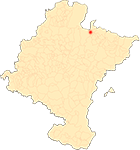Roncesvalles
By Javier Martínez de Aguirre Aldaz
Vestiges of the Caritat
One of the oldest monumental elements is the wall of the great hospital which in the Middle Ages, average, was called the Caritat. Donations and rents received throughout the 12th century enabled the construction of a monumental building to cater for the continuous increase in the number of pilgrims. A poem written at the beginning of the 13th century and contained in the codex La Preciosa indicates the existence of two houses for the sick, one for men and the other for women, as well as the storeroom, the church and the funeral chapel. A wall of considerable dimensions remains from those distant times (the foundations of the front wall were found years ago in the small garden located between the house of the beneficiaries and the Library Services). We are possibly looking at the remains of the "new hospital" mentioned in a document from 1203. Built with a medium-sized masonry, the facing extends in an east-west direction, opposite the main door of the collegiate church. It has a walled doorway that resembles the central openings of the royal palace of Pamplona at the end of the 12th century. The first courses of the transverse stone arches, four on each side of the doorway, can also be seen. They started from curved corbels with smooth crests and supported the simple wooden gabled roof. The building had a floor area of more than 500 m2. Its interior appearance was similar to Itzandeguía, which we will talk about later. This was the most frequent subjectin medieval hospital buildings in Navarre, as evidenced by remains that have survived to the present day in Larrasoaña, Velate, etc.
The poem of La Preciosa (13th century) mentions the existence of two houses for the sick, one for women and the other for men, illuminated by divine light during the day and at night by lamps so bright that they resembled morning light. In the middle was an altar dedicated to Saints Catherine and Marina. The rooms were furnished with well-arranged beds. There was also a larder full of fruit from various sources. The bare wall hardly does justice to what was one of the most important Hispanic welfare buildings of its time.
Dectot, X., "Yacente de Sancho VII el Fuerte", in Bango Torviso, I.G. (dir. cient.), Sancho el Mayor y sus herederos. El linaje que europeizó los reinos hispanos, Pamplona, 2006, pp. 371-373.
Fernández-Ladreda, C., Imaginería medieval mariana en Navarra, Pamplona, 1989.
Fernández-Ladreda, C. (Dir.), Martínez Álava, C., Martínez de Aguirre, J. and Lacarra Ducay, M.C., El arte gótico en Navarra, Pamplona, 2015.
Fuentes y Ponte, J., report histórica y descriptiva del santuario de Nuestra Señora de Roncesvalles, Lérida, 1880.
García Gainza, M.C., Orbe Sivatte, M. and Domeño Martínez de Morentin, A., Catalog Monumental de Navarra IV**. Merindad de Sangüesa, Pamplona, 1992.
Ibarra, J., History of Roncesvalles. Art. History. Legend, Pamplona, 1936.
Lambert, E. Roncevaux", Bulletin Hispanique, XXXVII (1935), pp. 417-436.
Martínez de Aguirre, J. (coord.), Enciclopedia del Románico en Navarra, Aguilar de Campoo, 2008, vol. III, pp. 1216-1224.
Martínez de Aguirre, J., Gil Cornet, L. and Orbe Sivatte, M., Roncesvalles. Hospital and sanctuary on the Camino de Santiago, Pamplona, 2012.
Miranda García, F. and Ramírez Vaquero, E., Roncesvalles, Pamplona, 1999.
Peris, A., "El Ritmo de Roncesvalles: estudio y edición", Cuadernos de Filología Clásica. Latin Studies, 11 (1996), pp. 171-209.
Pons Sorolla, F., "project de obras de restauración en la capilla del Sancti Spiritus de la Real Colegiata de Roncesvalles (Navarra)", Príncipe de Viana, XXXIX (1978), pp. 59-77.
Soria i Puig, A., The Road to Santiago. II. Stations and signs, Madrid, 1992.
Torres Balbás, L. La iglesia de la hospedería de Roncesvalles", Príncipe de Viana, VI (1945), pp. 371-403.
Thuile, J., L'Orfèvrerie en Languedoc du XIIe au XVIIIe siècle. Généralité de Montpellier, Montpellier, 1966.












